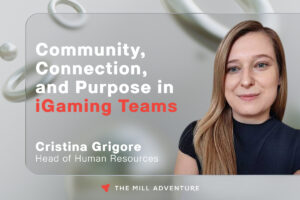Community, connection, and purpose in igaming teams

Cristina Grigore, head of Human Resources at The Mill Adventure, discusses the importance of fulfilment, satisfaction, and happiness at work.
Opinion.- Over the last year, the job market has seen some substantial turmoil, with established and highly successful technology companies making the tough call of downsizing, in response to changing economic conditions, as well as a result of unfit managerial decisions. One after another, we’ve seen work environments that were previously admired and revered become places of uncertainty and chaos.
The same circumstances have affected the iGaming industry and, considering how tightly knit the ecosystem is, we’ve all felt, to one degree or another, that the solid ground of being part of an iGaming team is not as stable as expected.
Conversely, our industry is still going strong, so companies are growing at a speed that can only be characteristic of a thriving business area — and people are and will remain the beating heart of the continued success of iGaming.
In this interesting and somewhat conflicting context, I find it appropriate to bring attention to the critical importance of fulfilment, satisfaction and, yes, the big word, happiness at work and how these elements generate that magical interdependence that leads to great results for the individuals, the teams, and the businesses alike.
It’s not a matter of novelty that empirical evidence shows teams need two key elements to deliver great work:
- trust between the members of the team as an expression of connection and community
- a shared understanding of their work purpose
What is indeed interesting is that neurological studies demonstrate that these elements generate a hormonal response that enables people to perform in a happy, fulfilling and highly effective way – and that is the production of oxytocin.
With this insight, it becomes undebatable that creating and improving work cultures cannot be done sustainably without genuine care and without investing teams with trust and offering them purpose.
The fact of the matter is that trust and purpose sometimes appear to magically be present in some companies, and certain work environments demonstrate them more than others. But this appearance is deceiving, for these elements are and should be treated as strategic assets.
By investing in and paying attention to trust and purpose, companies can gain three important benefits: happy team members, better organizational performance, and strengthened communities.
As far as connectivity is concerned, especially in the form of team trust, my own experience (and that of many others I’ve worked with) shows me that building it requires that one of the involved parties starts from a place of positive assumption.
It may sound simplistic, but when receiving trust in a way that is not perceived as transactional, the mirroring effect almost always immediately appears. In more obvious terms, by investing teams with trust, a leader or an organization starts a chain reaction, meaning the members of the team tend to trickle down that trust. And this is only the beginning of a virtuous circle because trust and positive assumptions, naturally give way to empathy. In turn, empathy creates an environment where the community is strong and mutual support moves teams and individuals forward most strongly and uniquely.
When it comes to purpose, I find the concept is often misinterpreted, in the sense that team purpose is confused with personal values. Both concepts are incredibly impactful, but very different nonetheless. So, when it comes to team and organizational purpose, it is critical to underline that it refers to the reason why that organization and team exist and how each individual contributes to reaching that reason. That is to say, the team purpose can be absolutely anything, as long as it is consistently, repeatedly, and clearly communicated to and understood by the team.
So, how can companies start and continue to build community, connection, and purpose and make them a constant component of the organizational culture? The response list is not exhaustive, but these are great elements to start from:
- recognize effort and performance
- define achievable expectations, challenging but achievable
- empower, enable, and train teams
- transfer knowledge constantly
- communicate information honestly, even when it might not be what the team wants to hear
- encourage relationship building
- promote growth and development
- build a safe environment where people can be authentic and vulnerable
At The Mill Adventure, we take pride in our distinct culture: we offer trust as part of the onboarding package and, together, we stand behind our purpose of reinventing the iGaming industry and becoming a leader in digital entertainment through technology, data, and simplicity.











